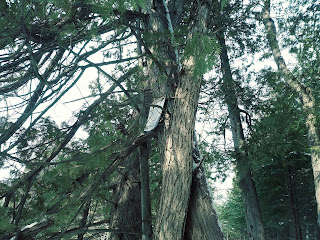Water Pathways: Exhibition

 Water Pathways was installed at the Sudbury School of Architecture in early May. The works by children ages 4-6 were created during an intensive artist-in-residency last year. I designed a process-based engagement that involved daily walks to conduct field research, the use of creative field research methods, collaboration on field drawings in oversized fieldbooks, collecting and observing natural materials that provided cues and clues connected to our questions. We explored on and below the ground, from the ground to the canopy, and above the canopy. We walked, we touched, we listened, we observed. We leaned into the ecology of the bush and rock behind the school. We followed its pathways and listened to what it could teach us. We used charcoal, graphite, drawing pens, watercolour, clay, and stitching to explore a number of research questions, all of which stemmed from the children's preliminary observation of water pooling and running in the spring playground: Where does the water come from? Where is it going? The children's curiosity ran off into queries such as: Can water go through wood? How does the water travel up a tree and get to the leaves?
Water Pathways was installed at the Sudbury School of Architecture in early May. The works by children ages 4-6 were created during an intensive artist-in-residency last year. I designed a process-based engagement that involved daily walks to conduct field research, the use of creative field research methods, collaboration on field drawings in oversized fieldbooks, collecting and observing natural materials that provided cues and clues connected to our questions. We explored on and below the ground, from the ground to the canopy, and above the canopy. We walked, we touched, we listened, we observed. We leaned into the ecology of the bush and rock behind the school. We followed its pathways and listened to what it could teach us. We used charcoal, graphite, drawing pens, watercolour, clay, and stitching to explore a number of research questions, all of which stemmed from the children's preliminary observation of water pooling and running in the spring playground: Where does the water come from? Where is it going? The children's curiosity ran off into queries such as: Can water go through wood? How does the water travel up a tree and get to the leaves?I taught the children how to use the tools, I invited them to explore the materials to learn what they can do and how each material expresses differently; the children, however, made their own choices about what to draw or paint, they learned techniques through the making and found their own agency with the materials.
The research, the thinking, the connection making, and the work created are interdisciplinary and interconnected: ecology, design, the architecture of space, land use, relational learning, collaboration, embodied practices, connecting heart and the land, stewardship, and even engineering (the making of a cloud machine).
The project and the exhibition demonstrate that children's work is real art, and real research. The project also invites us to consider how we engage with children, the boundaries of learning, educational structures, and the importance of collaboration between children and adults.
The ongoing openness and curiosity of the teacher, an ethos of open-ended research, and the vitality of conversations and discussion were crucial to this project. At this juncture we need to change how we think, how we think about learning, and radically change our relationship to the ecologies in which we live. We need to integrate thinking, learning, living, our hands, our feet, our hearts, the land.
These kinds of projects require a 'whole' classroom, and a team. We had an amazing one.
Art work: children in the Kindergarten class at R.L. Beattie Public School
Artist: sophie anne edwards
Teacher: Julie Kelly
Documentation: Sharon Speir
Panel design: Karli Laamanen
Exhibition photos: sophie anne edwards
Funders/donations: Ontario Arts Council, Rainbow District School Board, R.L. Beattie,
Sharon Speir
Articles about this project are forthcoming.





Comments